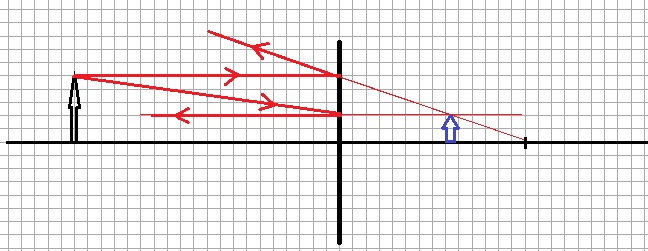All Solutions
Page 483: Standardized Test Practice
Magnification is smaller than $1$ if the image is **smaller than the object**.
This will happen only if the object is **past the center of curvature**.
begin{align*}
&M=+3.2\
&d_{o}=30 hspace{0.5mm} mathrm{cm}
end{align*}
begin{align*}
M&=- frac{d_{i}}{d_{o}}/ cdot -d_{o}\
d_{i}&=-Md_{o}\
d_{i}&=- (+3.2) cdot 30 hspace{0.5mm} mathrm{cm}\
d_{i}&=- 96 hspace{0.5mm} mathrm{cm}
end{align*}
begin{align*}
frac{1}{f}&= frac{1}{d_{i}} + frac{1}{d_{o}} \
frac{1}{f}&= frac{d_{o}+d_{i}}{d_{i} cdot d_{o}}
end{align*}
begin{align*}
frac{1}{f}&= frac{d_{o}+d_{i}}{d_{i} d_{o}}\
f&=frac{d_{i} d_{o}}{d_{o}+d_{i}}\
end{align*}
$$
begin{align*}
f&=frac{d_{i} d_{o}}{d_{o}+d_{i}}\
f&=frac{(-96 hspace{0.5mm} mathrm{cm}) 30 hspace{0.5mm} mathrm{cm}}{30 hspace{0.5mm} mathrm{cm}-96 hspace{0.5mm} mathrm{cm}}\
f&=frac{-2880 hspace{0.5mm} mathrm{cm^{2}}}{-66 hspace{0.5mm} mathrm{cm}}\
f&=43.4 hspace{0.5mm} mathrm{cm}\
f& approx 44 hspace{0.5mm} mathrm{cm}
end{align*}
$$
begin{align*}
&d_{o}=21 hspace{0.5mm} mathrm{cm}\
&f=14 hspace{0.5mm} mathrm{cm}
end{align*}
$$
begin{align*}
frac{1}{f} &= frac{1}{d_{o}}+ frac{1}{d_{i}} / – frac{1}{d_{o}} \
frac{1}{d_{i}}&= frac{1}{f} – frac{1}{d_{o}}
end{align*}
$$
begin{align*}
frac{1}{d_{i}}&= frac{1}{f} – frac{1}{d_{o}} \
frac{1}{d_{i}}&= frac{d_{o}- f}{f cdot d_{o}}
end{align*}
begin{align*}
frac{1}{d_{i}}&= frac{d_{o}- f}{f cdot d_{o}}\
d_{i}&= frac{f cdot d_{o}}{d_{o}- f}
end{align*}
$$
begin{align*}
d_{i}&= frac{f cdot d_{o}}{d_{o}- f}\
d_{i}&= frac{14 hspace{0.5mm} mathrm{cm} cdot 21 hspace{0.5mm} mathrm{cm}}{21 hspace{0.5mm} mathrm{cm}- 14 hspace{0.5mm} mathrm{cm}}\
d_{i}&= frac{294 hspace{0.5mm} mathrm{cm^{2}}}{7 hspace{0.5mm} mathrm{cm}}\
d_{i}&= 42 hspace{0.5mm} mathrm{cm}
end{align*}
$$
Which further means that defective spherical mirror will not properly focus rays at the focal point.
$$theta_r=theta_i$$
$$theta_r=23^o$$
$$alpha=90^o-theta_r$$
Inserting values we get:
$$alpha=90^o- 23^o$$
Finally:
$$boxed{alpha=67^o}$$
$$
theta = 90 – 23 = 67 text{textdegree}
$$
67 text{textdegree}
$$
$$frac{1}{d_o}+frac{1}{d_i}=frac{1}{f}$$
From the previous equation we can express $d_o$:
$$frac{1}{d_o}=frac{1}{f}-frac{1}{d_i}$$
$$frac{q}{d_o}=frac{d_i-f}{fd_i}$$
And finally:
$$d_o=frac{fd_i}{d_i-f}$$
$$d_o=frac{24cdot 34.5}{34.5-24}$$
$$d_o=78.86,,rm{cm}$$
$$frac{h_i}{h_o}=-frac{d_i}{d_o}$$
$$h_o=h_ifrac{d_o}{d_i}$$
Inserting values we get:
$$h_o=-(-8.5)cdot frac{78.86}{34.5}$$
$$boxed{h_o=19,,rm{cm}}$$
$dfrac{1}{d_o} = dfrac{1}{f} – dfrac{1}{d_i}$
$dfrac{1}{d_o} = dfrac{1}{24.0} – dfrac{1}{34.5}$
$dfrac{1}{d_o} = 0.01268$
$d_o = 78.86 cm$
The height of the object is:
$$
h_o = -h_i (dfrac{d_o}{d_i}) = -(-8.5) (dfrac{78.86}{34.5}) = 19 cm
$$
19 cm
$$
begin{align*}
&d_{i}=38.6 hspace{0.5mm} mathrm{cm}\
&f=16 hspace{0.5mm} mathrm{cm}
end{align*}
$$
begin{align*}
frac{1}{f} &= frac{1}{d_{o}}+ frac{1}{d_{i}} / – frac{1}{d_{i}} \
frac{1}{d_{o}}&= frac{1}{f} – frac{1}{d_{i}}
end{align*}
$$
begin{align*}
frac{1}{d_{o}}&= frac{1}{f} – frac{1}{d_{i}} \
frac{1}{d_{o}}&= frac{d_{i}- f}{f cdot d_{i}}
end{align*}
begin{align*}
frac{1}{d_{o}}&= frac{d_{i}- f}{f cdot d_{i}}\
d_{o}&= frac{f cdot d_{i}}{d_{i}- f}
end{align*}
$$
begin{align*}
d_{o}&= frac{f cdot d_{i}}{d_{i}- f}\
d_{o}&= frac{16.0 hspace{0.5mm} mathrm{cm} cdot 38.6 hspace{0.5mm} mathrm{cm}}{38.6 hspace{0.5mm} mathrm{cm}- 16.0 hspace{0.5mm} mathrm{cm}}\
d_{o}&= frac{617.6 hspace{0.5mm} mathrm{cm^{2}}}{22.6 hspace{0.5mm} mathrm{cm}}\
d_{o}&= 27.3 hspace{0.5mm} mathrm{cm}
end{align*}
$$
begin{align*}
&d_{i}=-8.4 hspace{0.5mm} mathrm{cm}\
&M=3/4
end{align*}
begin{align*}
M&=- frac{d_{i}}{d_{o}}/ cdot -(d_{o}/M)\
d_{o}&=-frac{d_{i}}{M}\
d_{o}&=-frac{-8.4 hspace{0.5mm} mathrm{cm}}{0.75}\
d_{o}&=11.2 hspace{0.5mm} mathrm{cm}
end{align*}
begin{align*}
frac{1}{f}&= frac{1}{d_{i}} + frac{1}{d_{o}} \
frac{1}{f}&= frac{d_{o}+d_{i}}{d_{i} cdot d_{o}}
end{align*}
begin{align*}
frac{1}{f}&= frac{d_{o}+d_{i}}{d_{i} d_{o}}\
f&=frac{d_{i} d_{o}}{d_{o}+d_{i}}\
end{align*}
$$
begin{align*}
f&= frac{d_{i} d_{o}}{d_{o}+d_{i}}\
f&= frac{-8.4 hspace{0.5mm} mathrm{cm} cdot 11.2 hspace{0.5mm} mathrm{cm}}{11.2 hspace{0.5mm} mathrm{cm}- 8.4 hspace{0.5mm} mathrm{cm}}\
f&= frac{-94.8 hspace{0.5mm} mathrm{cm^{2}}}{2.8 hspace{0.5mm} mathrm{cm}}\
f&= -33.6 hspace{0.5mm} mathrm{cm}\
f& approx -34 hspace{0.5mm} mathrm{cm}
end{align*}
$$
The magnification is negative, therefore the image is inverted.
– Distance of a cup from the mirror: $d_{cup}=17mathrm{~cm}$
– Distance of a image from the mirror: $d_i=35mathrm{~cm}$
**Objective**
Find the magnification $M$.
Magnification $M$ is defined as negative distance of a image from the mirror $-d_i$ divided by the distance of a object creating the image from the mirror $d$:
$$begin{align}
M=dfrac{-d_i}{d}
end{align}$$
In our case object is the cup, so the distance of a object from the mirror is $d=d_{cup}$. Using this and formula $(1)$, we can simply calculate magnification $M$.
$$begin{aligned}
M&=dfrac{-d_i}{d}
\&=dfrac{-d_i}{d_{cup}}
\&=dfrac{-35mathrm{~cancel{cm}}}{17mathrm{~cancel{cm}}}
\&=boxed{-2.06}
end{aligned}$$
Since the magnification is negative, the image is inverted.


